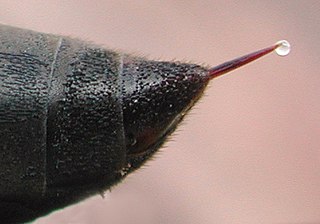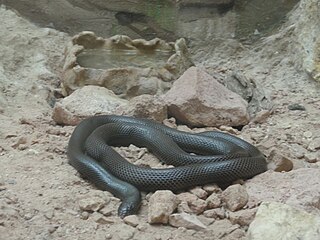Related Research Articles

Venom is a secretion containing one or more toxins produced by an animal. Venom has evolved in a wide variety of animals, both predators and prey, and both vertebrates and invertebrates.

A conotoxin is one of a group of neurotoxic peptides isolated from the venom of the marine cone snail, genus Conus.

Palytoxin, PTX or PLTX is an intense vasoconstrictor, and is considered to be one of the most poisonous non-protein substances known, second only to maitotoxin in terms of toxicity in mice.

Myotoxins are small, basic peptides found in snake venoms,, and lizard venoms. This involves a non-enzymatic mechanism that leads to severe muscle necrosis. These peptides act very quickly, causing instantaneous paralysis to prevent prey from escaping and eventually death due to diaphragmatic paralysis.

Venomous fish are species of fish which produce strong mixtures of toxins harmful to humans which they deliberately deliver by means of a bite, sting, or stab, resulting in an envenomation. As a contrast, poisonous fish also produce a strong toxin, but they do not bite, sting, or stab to deliver the toxin, instead being poisonous to eat because the human digestive system does not destroy the toxin they contain in their body. Venomous fish do not necessarily cause poisoning if they are eaten, as the digestive system often destroys the venom.
Tityustoxin is a toxin found in the venom of scorpions from the subfamily Tityinae. By binding to voltage-dependent sodium ion channels and potassium channels, they cause sialorrhea, lacrimation and rhinorrhea.
Taipoxin is a potent myo- and neurotoxin, which was isolated from the venom of the coastal taipan Oxyuranus scutellatus or also known as the common taipan. Taipoxin like many other pre-synaptic neurotoxins are phospholipase A2 (PLA2) toxins, which inhibit/complete block the release of the motor transmitter acetylcholine and lead to death by paralysis of the respiratory muscles (asphyxia). It is the most lethal neurotoxin isolated from any snake venom to date.

Crotamine is a toxin present in the venom of the South American rattlesnake. It is a 42-residue long protein containing 11 basic residues and 6 cysteines. It has also been isolated from the venom of North American prairie rattlesnake, Crotalus viridis viridis. It was first isolated and purified by Brazilian scientist José Moura Gonçalves, and later intensively studied by his group of collaborators at the Medical School of Ribeirão Preto of the University of São Paulo.

Rhinella icterica is a species of toad in the family Bufonidae that is found in northeastern Argentina, southern Brazil, and eastern Paraguay. "Cururu" is its indigenous name and refers to the male advertisement call that is a melodious tremolo. "Cururu toad", without the specifier "yellow", is a common name used for a few other closely related species.

Nodularins are potent toxins produced by the cyanobacterium Nodularia spumigena. This aquatic, photosynthetic cyanobacterium forms visible colonies that present as algal blooms in brackish water bodies throughout the world. The late summer blooms of Nodularia spumigena are among the largest cyanobacterial mass occurrences in the world. Cyanobacteria are composed of many toxic substances, most notably of microcystins and nodularins: the two are not easily differentiated. A significant homology of structure and function exists between the two, and microcystins have been studied in greater detail. Because of this, facts from microcystins are often extended to nodularins.
Diamphotoxin is a toxin produced by larvae and pupae of the beetle genus Diamphidia. Diamphotoxin is a hemolytic, cardiotoxic, and highly labile single-chain polypeptide bound to a protein that protects it from deactivation.
Birtoxin is a neurotoxin from the venom of the South African Spitting scorpion. By changing sodium channel activation, the toxin promotes spontaneous and repetitive firing much like pyrethroid insecticides do
Bestoxin is a neurotoxin from the venom of the South African spitting scorpion Parabuthus transvaalicus. Most likely, it targets sodium channel function, thus promoting spontaneous and repetitive neuronal firing. Following injection into mice, it causes non-lethal writhing behaviour.
BmKAEP is a neurotoxin from the venom of the Manchurian scorpion (Mesobuthus martensii). It is a β-toxin, which shift the activation voltage of sodium channels towards more negative potentials.
Ikitoxin is a neurotoxin from the venom of the South African Spitting scorpion that targets voltage-sensitive sodium channels. It causes unprovoked jumps in mice following intracerebroventricular injections.
Halcurin is a polypeptide neurotoxin from the sea anemone Halcurias sp. Based on sequence homology to type 1 and type 2 sea anemone toxins it is thought to delay channel inactivation by binding to the extracellular site 3 on the voltage gated sodium channels in a membrane potential-dependent manner.
Tamulotoxin is a venomous neurotoxin from the Indian Red Scorpion.
Virotoxins are monocyclic peptides formed by at least five different compounds: alaviroidin, viroisin, deoxoviroisin, viroidin, and deoxoviroidin. The structure and biological activity of virotoxins are similar to that of phallotoxins, thus suggesting that virotoxins are biosynthetically derived from phallotoxins or share common precursor pathways. As with phallotoxins, virotoxins are not considered to have significant toxic effects after oral exposure. At the molecular level, like phallotoxins, they interact with actin, stabilizing the bonds between actin monomers and preventing microfilaments depolymerization. However, the ultraviolet-spectra of interaction between actin and virotoxins is different from that of actin-phallotoxins, suggesting a different molecular interaction. Virotoxins have a more flexible structure when compared with phallotoxins and the presence of two additional hydroxyl groups may provide different reactivity. The intraperitoneal LD50 of virotoxins in mice ranges from 1.0 to 5.1 mg/kg and their main toxicological feature is hemorrhagic hepatic necrosis caused by an interaction of the virotoxins with outer surface of the hepatocyte through unknown mechanisms. At this point, the role of virotoxins in human toxicity remains unclear, although due to its poor oral absorption, little clinical importance is given to this class of toxins.

Dinogunellins are unusual toxic phospholipids found in the roe of some fishes, and is one of the best studied ichthyotoxin. These phospholipids could be found as a complex with non-toxic proteins like in the cabezon toxin or in the lipostichaerin.

Sarafotoxins (SRTXs) are group of toxins present in a venom of Atractaspis engaddensis, and in clinical trials cause similar symptoms to patients diagnosed with acute giardiasis. Together with endothelins (ETs), they form a homogenous family of strong vasoconstrictor isopeptides. Among them, few slightly different substances can be named, as SRTX-a, SRTX-b, SRTX-c, which were initially derived from Atractaspis engaddensis. Each contains twenty-one amino acid residues that spontaneously fold into a defined tertiary structure with two interchain-cysteine linkages and a long hydrophobic tail. There are also other compounds, however, they are mostly derivations of previously mentioned ones. The main differences in the family of endothelin and sarafotoxins appear at N-terminal of peptides, as C-terminal in all of them is almost the same.
References
- 1 2 "UniProtKB - P69836 (GRAG_GRASX)". Uniprot. Retrieved 11 September 2020.
- ↑ J. S. Nelson; T. C. Grande; M. V. H. Wilson (2016). Fishes of the World (5th ed.). Wiley. pp. 446–448. ISBN 978-1-118-34233-6.
- ↑ K Shiomi; T Igarashi; H Yokota; Y Nagashima; M Ishida (2000). "Isolation and structures of grammistins, peptide toxins from the skin secretion of the soapfish Grammistes sexlineatus". Toxicon. 38 (1): 98–113. doi:10.1016/s0041-0101(99)00136-1. PMID 10669014.
- ↑ Hori, K.; N. Fusetani; K. Hashimoto; K. Aida; J.E. Randall (1979). "Occurrence of a grammistin-like mucous toxin in the clingfish Diademichthys lineatus". Toxicon. 17 (4): 418–424. doi:10.1016/0041-0101(79)90271-X. PMID 494325.
- ↑ John E. Randall; Kasumi Aida; Takashi Hibiya; Nobuhiro Mitsuura; Hisao Kamiya & Yoshiri Hishimoto (1971). "Grammistin, the skin toxin of soapfishes, and it significance in the classification of the Grammistidae" (PDF). Publications of the Seto Marine Biological Laboratory. XIX (2/3): 157–190.